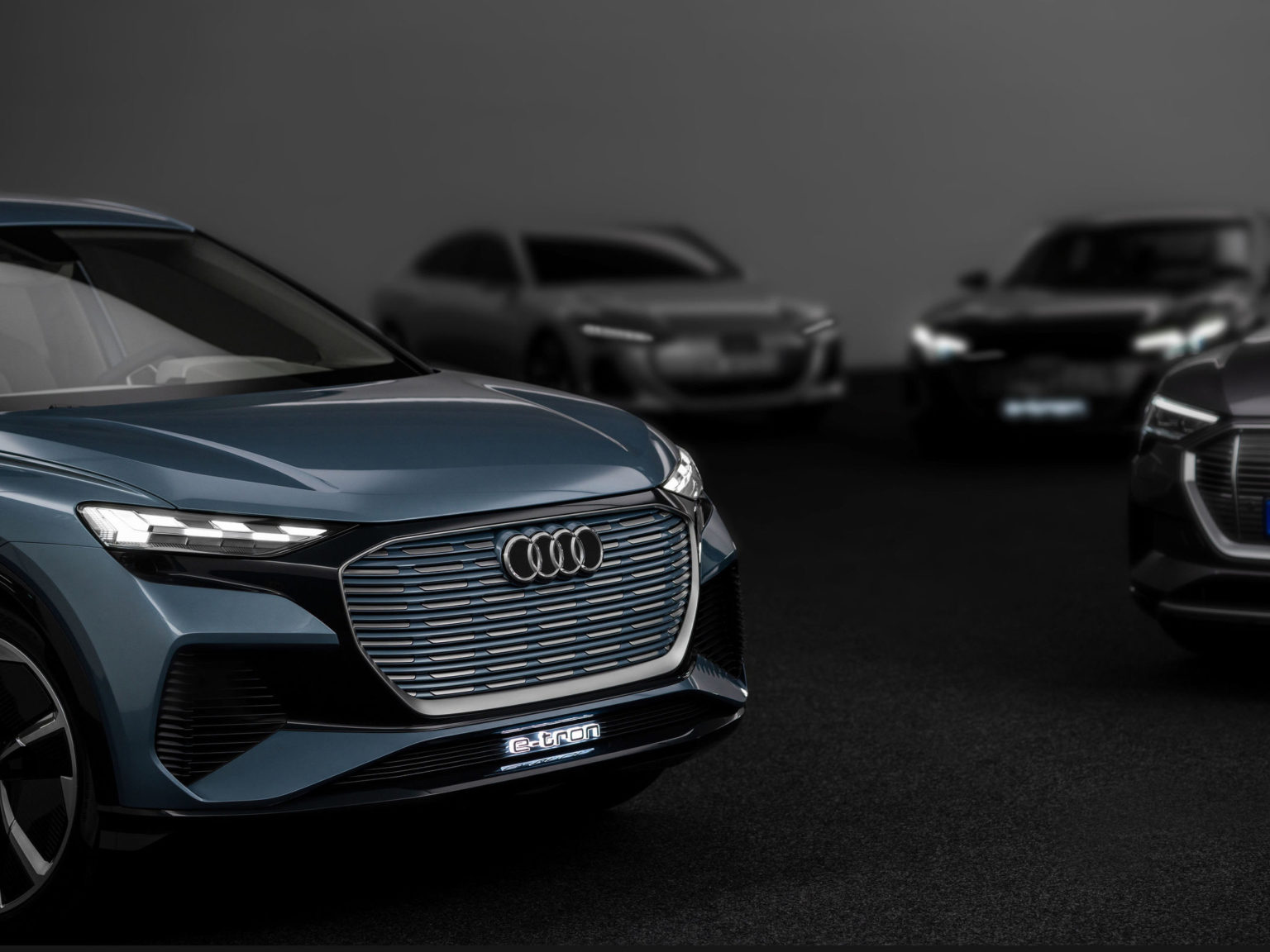Audi has committed to having 30 electrified models for sale by 2025, with 20 of those being full electric. The company’s promise falls into line with those of its parent company, Volkswagen, and the stated goals of all of the Volkswagen brands.
The German automaker already offers five premium electrified models for sale in the U.S. The Audi Q5 TFSI e, A7 TFSI e, and A8 TFSI e are all plug-in hybrid electric vehicles (PHEV). The Audi E-Tron SUV and Sportback.
Photo courtesy of Audi AG
Next up are the Audi Q4 E-Tron SUV and E-Tron GT performance sedan. These two models have already been shown in concept form.
Globally, Audi anticipates it will reach production of approximately 800,000 electrified vehicles per year by 2025.
Audi’s upcoming all-electric vehicles will feature four different architectures. The company says that these models balance performance, efficiency, practicality, and the engineering and craftsmanship buyers have come to expect from the German automaker.
– [ ]
Photo courtesy of Audi AG
MLB Evo Platform
The Audi E-Tron SUV has a wheelbase of 114.3 inches putting it between the Audi Q5 and Q7 in the automaker’s lineup. It has a battery pack that stores up to 05 kWh of energy and can recover 30 percent of the energy used during driving via regenerative braking.
The E-Tron platform houses two asynchronous electric motors that produce 402 horsepower in Boost mode. A more powerful, three-motor variant (possibly for an E-Tron S or RS-type model) is under development.
It has a power electronics module that is able to read sensor data 10,000 times per second and output those values allowing the motors to assist with traction depending on road conditions. This all-wheel drive system can redistribute torque to wheels with traction during a slippage situation in just 30 milliseconds.
The models can charge using Level 1, 2, and 3 current, achieving an approximately 80 percent charge in 30 minutes at a 150 kW high-speed public charger.
This platform is manufactured in a CO2-neutral plant in Brussels, Belgium. That factory has a rooftop solar array that is large enough to charge approximately 30,000 E-Tron SUVs.
Photo courtesy of Audi AG
The new E-Tron Sportback will join the Audi lineup later this year and feature a sloped roofline giving the SUV a sportier appearance than can be found in the E-Tron SUV.
J1 Platform
The recently revealed Audi E-Tron GT concept performance sedan shows how Audi envisions their sports-centric car lineup evolving in an electric era. The model features engineering with the Porsche brand, which developed the J1 architecture, the platform that underpins the Porsche Panamera.
Audi has designed the E-Tron GT concept to feature two permanently excited synchronous motors that deliver 582 horsepower and 612 pound-feet of torque. The motors have permanent magnets in them and a natural internal magnet field. In this type of motor, the rotor moves in coordination with the magnetic field of the stator (the stationary part of the motor in which the rotor rotates). This puts the “permanently excited” in its name.
Audi reports that the electric system inside the E-Tron GT concept runs at 800 volts. Typical systems run at 400 volts. The increased amount is possible because of the car’s energy management and cooling systems.
Retail-ready stats for the car aren’t available yet, but the concept car is estimated in to reach 62 mph in 3.5 seconds and 124 mph in just over 12 seconds. Like other E-Tron models, it was fashioned with all-wheel drive with dynamic torque management.
The E-Tron GT is able to charge to 80 percent of its battery capacity in 20 minutes at a Level 3 DC fast charger.
Photo courtesy of Audi AG
MEB Platform
The Audi Q4 E-Tron concept was deigned to deliver affordability alongside technical sophistication. This model utilizes the company’s MEB platform, which anchors other Volkswagen family vehicles. Using the same platform across multiple vehicle offerings allows automakers to keep costs down, allowing vehicles to be more affordable for buyers.
The MEB platform is able to accommodate a variety of electric motors and lithium-ion batteries. It offers a wheelbase and battery storage design that allows for the maximization of passenger space. According to Audi, “The Q4 e-tron is expected to be the first Audi model based on the MEB platform, with exterior dimensions comparable to those of the Q3 but with the interior dimensions of a significantly larger vehicle. The architecture also offers new design opportunities and offers different performance levels and powertrain configurations.”
A variety of motor and power configurations are allowed for in this platform. The electrical architecture allows for 800 volts of power, what the J1 delivers.
Photo courtesy of Audi AG
PPE Platform
Co-developed with Porsche, the PPE architecture is a high-tech, scalable platform that allows for low- and high-floor vehicles that are medium-size and up and is designed to be offered in vehicles for the global market.
A number of powertrain and battery options will be available. Standard packaging will allow for one electric motor in the rear; the higher-range models will be equipped with a second electric motor at the front axle that can activate all-wheel drive functionality when needed.
Despite all this engineering and development, the question remains, “Do people want to buy electric vehicles?” A recent Ford Trends report revealed that one-third of those surveyed globally had no interest in owning one.








